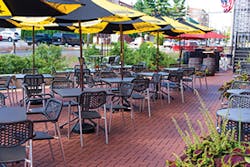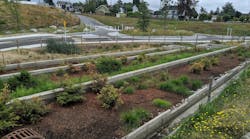If you need to build a municipal project, it makes sense to make it green—especially if it brings you into compliance with EPA, saving taxpayer dollars at the same time.
Case in point: Lancaster, PA, and the plans it has made to deal in a proactive way with combined sewer overflows (CSOs).
An EPA case study, “The Economic Benefits of Green Infrastructure,” details how in 2011, Lancaster released a comprehensive green infrastructure plan that set out a number of goals, opportunities, and recommendations for implementing green infrastructure in the city.
The case study is in line with the agency’s goal to examine—and find ways to distribute—best practices that can then be used by other municipalities pursuing similar plans.
As it turns out, where it comes to stormwater, Lancaster has plenty of company. It’s one of more than 700 communities across the United States that has a combined sanitary and storm sewer system and sends water to a treatment plant.
Most of the time, the systems work fine, but on rainy days, the system overflows, dumping untreated sewage and stormwater directly into streams and rivers. But unlike many cities, Lancaster has come up with a way to deal with it.
In Lancaster’s case, CSOs dumped approximately 750 million gallons of untreated wastewater and stormwater into the Conestoga River, EPA found. The Conestoga flows into the Susquehanna River, which flows into the Chesapeake Bay.
Despite significant progress in gray infrastructure (man-made structures that move, store, and treat stormwater, such as pipes, holding tanks, and treatment plants), the city estimated that the price tag to rely on gray infrastructure alone in managing the CSOs would be more than $250 million.
By comparison, the cost to implement the plan over 25 years using green infrastructure citywide would be either $141 million if the projects started out as green infrastructure or $77 million, which would be the additional cost of adding green infrastructure to an improvement project already being planned. That would include such things as paving a planned parking lot with permeable pavement instead of a conventional asphalt-and-storm-drain design.
EPA’s case study said that leveraging other projects is generally more cost effective than undertaking standalone green infrastructure projects and can result in more widespread implementation.
Other savings would also be seen from adopting green infrastructure. The case study estimated that implementation of Lancaster’s plan would provide approximately $4.2 million in energy, air-quality, and climate-related benefits each year across the entire city. Additionally, the plan was estimated to reduce gray infrastructure capital costs by $120 million and reduce wastewater pumping and treatment costs by $661,000 annually.
As with many other areas, Lancaster has combined sewer in some parts of the city and a separate system for stormwater in other parts. EPA said that the benefits exceed the costs of providing green infrastructure in those parts of the city that have a combined sewer. In those areas alone, green infrastructure would cost $51.6 million if integrated into planned improvement projects and $94.5 million if built into standalone projects. In both, EPA said, the environmental and economic benefits provided by green infrastructure would continue to accrue year after year.
The Overall Goal
Far from government regulation and debate, the reason for concern over water quality might just boil down to whether, in the years to come, you can order a plate of local seafood at a restaurant in Baltimore.
That’s because Lancaster’s runoff ultimately ends up in the Chesapeake Bay. Ranked as the largest body of water of its kind in the United States, it has more than 150 major rivers and streams from six states and the District of Columbia flowing into its drainage basin.
It’s in trouble and has been for a long time.
With its stock of crabs and oysters—and businesses that earn their living from them—declining in numbers, the Chesapeake is a visible example of what happens when water pollution continues unabated upstream for decades.
Most would agree that problems with water quality within the Chesapeake Bay are the outcome of unintentional actions, which were caused in large part by a collision between aging infrastructure and population growth. Many cities, which, like Lancaster, were settled long ago, have combined sewer systems.
More people mean more toilets, more showers, more washing machines—more volume in the sanitary sewer system. More people also means more stormwater: more streets and parking lots and buildings, which increase stormwater runoff because there is less open land for water to infiltrate.
More of both, mixed together and feeding into the same pipe, means more of a burden on wastewater treatment plants that were built when the population density was much less; more of a chance for a toxic spill into waterways; and, ultimately, more cost to the taxpayer.
What’s needed, then, is less.
Lancaster’s Response
Since the plan was completed four years ago, Lancaster has undertaken several projects and has several more in the planning stages.
One of them—the upgrade of the intersection of Plum and Walnut streets—used genuine clay permeable StormPave pavers from North Carolina-based Pine Hall Brick Company as one of its key components.
The pavers, which are almost identical to the Pine Hall Brick English Edge pavers that have been installed coast to coast for decades, work by using larger voids in between the pavers. Underneath, instead of a crusher-run and sand base, layers of precisely sized aggregates are put into place. The StormPave pavers are installed atop them. Rain or snowmelt enters the voids in the aggregate underneath, where it is stored briefly before seeping into the ground, where it is naturally filtered.
Last year, the Chesapeake Stormwater Network announced that the project won the Grand Prize—the Best Urban BMP [best management practice] in the Bay Award, or BUBBA.
The stormwater network—made up of nearly 4,000 stormwater professionals throughout the Chesapeake Bay watershed, which runs from New York south through several states to Virginia—began the competition to recognize innovative approaches to handle stormwater.
The network noted that the project effectively transformed a low-lying intersection that had a large concrete island and a dangerous merge lane into a model for stormwater management, enhanced pedestrian amenities, improved traffic safety, and increased commercial activity.
A large outdoor dining patio and diagonal parking spaces, both with StormPave permeable pavers, was built at the Lancaster Brewing Company. The once-concrete-and-asphalt intersection is now home to native shrubs, perennials, ornamental grasses, and new tree species surrounding the outdoor café.
Adjacent to the dining patio is a sculpture, built by an artist, made with a framework of steel and irregular native woods that hides a 700-gallon cistern. The installation captures stormwater from the roof for watering planters that are used by the brewery’s owners to grow their own produce. The building itself is an example of recycling: It’s a repurposed brick warehouse.
John McGrann, owner of Penn Stone, a Pine Hall Brick Company dealer, says the use or permeable paving is seeing increased popularity in the area around Lancaster.
The project at Plum and Walnut, he says, makes good economic sense on a couple of different levels. Lancaster is under an EPA mandate to either come up with a way to solve the CSO problem, or EPA will require the city to build a series of expensive graywater holding tanks. The tanks are designed to hold the water from the combined sewer system long enough to give the treatment plant time to treat all of it before it’s discharged into the river.
“We can either spend the money or we can explore the alternatives that are out there,” says McGrann. “We can get in compliance with the EPA requirements through a strategy of green infrastructure for half the investment and create some interesting infrastructure in the process.”
Early examples, in addition to the intersection project, have included the use of porous pavement instead of solid asphalt to build basketball courts, and a combination of porous pavement and permeable pavers to replace an alleyway, McGrann says.
“From what I hear, we’re getting held up as an example of discovering good solutions instead of being confrontational and getting forced into a bad solution,” he says.
And at a substantial savings today and into the future, at that.
About the Author
Walt Steele
Walt Steele is the president and CEO of Pine Hall Brick Company, a clay paver manufacturer in the United States. Steele represents the fourth generation of management in the family-owned company, which was founded in 1922. Based in Winston-Salem, North Carolina, Pine Hall Brick manufactures face, paving and special shape clay brick for the residential and commercial construction industry. It operates plants in North Carolina and Georgia and sells brick products in more than 35 different states.


